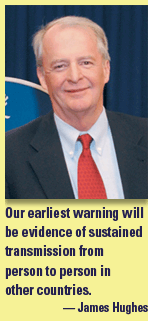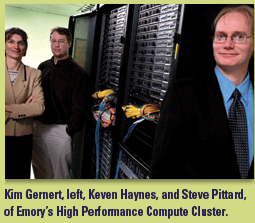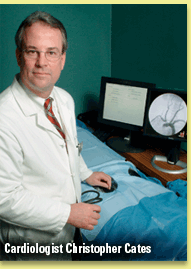|
 |
|
|















|

|
|
|
 |
Highlights:

|
 |
 |
 |
The
'bird flu' and beyond
Show me the numbers
Pool your computing power
Milestones
"Mission
rehearsal" means safer stenting
We remember
 |
 |
 |
 |
 |
 |
The
'bird flu' and beyond
If
Emory immunologist Richard Compans is successful, the world
will soon have a powerful new weapon to combat the spread of avian
influenza.
Researchers in the School of Medicine’s
Department of Microbiology and Immunology, which Compans chairs,
have genetically engineered virus particles that mimic the outward
appearance of the bird flu virus but lack the viral genetic material
that would infect other cells. When injected into a host, they prompt
the immune system to develop antibodies that can fight off the virus.
These man-made elements, known as virus-like particles (VLPs), could
form the basis for a new flu vaccine-—one that can be produced
much faster and more safely than the existing one.
“VLP vaccines could be made quickly and tailored to match
any of the strains of virus that are circulating in a given flu
season,” says Compans.
Research into new vaccine technology
is just one way that Emory is working with national leaders to address
the threat posed by avian flu.
This fall, outbreaks in Asia and Eastern
Europe set world health officials’ nerves on edge and left
them wondering if this would be the season a deadly new epidemic
would begin its sweep around the globe.
Genetic analysis of the 1918 flu virus,
which killed 25 million to 50 million people worldwide, indicates
that it also originated in birds. Rapid population growth and increased
global travel mean most of the world’s inhabitants are vulnerable
to new infectious diseases no matter where they emerge.
“SARS was the wakeup call for
many people,” says James Hughes, former director of the National
Center for Infectious Diseases at the CDC and now a professor of
medicine and global health who directs Emory’s program in
Global Infectious Diseases. “It demonstrated that we are a
global society and that infectious diseases can spread internationally—as
it did in that case—overnight.”
An outbreak of a new strain of influenza
would probably be more devastating. Unlike SARS patients, a person
infected with the flu can spread it even before symptoms appear.
Flu viruses also mutate quickly. The strains emerging in Asia are
very different from those that regularly circulate among human patients.
Global health experts like Hughes
and Walter Orenstein, director of the Emory Program for Vaccine
Policy and Development and former head of the CDC’s National
Immunization Program, have known for years that the possibility of another deadly flu pandemic is not
a question of if, but when.
years that the possibility of another deadly flu pandemic is not
a question of if, but when.
“Virtually all influenza experts
predict there will be another pandemic,” says Orenstein. “What
is not clear is when that pandemic will occur and what specific
virus will be the cause.”
In November, the Emory-based Southeastern
Center for Emerging Biologic Threats convened a meeting of public
health leaders from throughout the region to discuss strategies.
Representatives from the CDC presented the draft of the federal
Influenza Pandemic Response and Preparedness Plan, and experts in
infectious disease and public health law discussed large-scale strategies
to contain local outbreaks. State leaders viewed sample preparedness
plans and compared their own.
“Multiple issues must be addressed
in the plans,” says Orenstein. “For example, how will
distribution of vaccines be prioritized? Should we stockpile drugs
like neuraminidase inhibitors, which may be helpful in treatment
and prevention? At what point should we start closing schools and
workplaces and calling off sporting events?”
State and local leaders must also
prepare for surges in demand for health care services, including
the need for hospital and ICU beds and ventilators.
“We need laboratory diagnostic
capacity to determine which people are infected and which are not,
as well as a strong communications plan for the general public,
patients, and health care workers,” Orenstein says.
At Emory, a special task force is
developing a plan for how the campus will respond if avian flu is
detected in the United States.
Whether avian flu turns out to be a pandemic strain, it’s
vital that national leaders continue to make preparation a top priority,
says Hughes.
State leaders must understand what
their responsibilities are and what they can expect from the federal
government, he adds. Confusion in this area severely impaired the
response to Hurricane Katrina, and with a pandemic there will be
no swirling cloud on a radar screen.
“Most likely our earliest warning
will be evidence of sustained transmission from person to person
in other countries, and that will depend on timely identification
and confirmation of cases in the affected areas, which can be a
problem,” he says. “Our response will depend on effective
leadership at the national, state, and local levels and high levels
of international cooperation and communication.”
|
 |
 |
| |
|
|
|
| |
 |
Show
me the numbers
By
Sylvia Wrobel
Ever wonder how The Emory Clinic’s EBDIT affects the
AEF? And how are the clinical research studies managing their indirect
cost recovery?
If this sounds like Greek to you,
then you haven’t heard about Numbers Day. That’s the
one day each month that medical school department chairs, hospital
chief operating officers, and the CFOs of different components of
the Woodruff Health Sciences Center (WHSC) get together with the
Woodruff Leadership Council to go over the big financial picture.
Simply put, Numbers Day details where
WHSC’s money comes from and where it goes.
The meeting got its impetus as one
key element of the Vision 2012 strategic plan, a timeline projecting
the WHSC as a “destination of choice” for those seeking,
practicing, learning, and pioneering health care at its best, according to WHSC CEO Michael Johns. Vital
to realizing this vision is transparency in the organization.
health care at its best, according to WHSC CEO Michael Johns. Vital
to realizing this vision is transparency in the organization.
Numbers Day is helping department
chairs and faculty better understand the clinical enterprise so
they can help maximize its success. While chairs routinely understood
revenues and expenses in their individual departments, they typically
knew very little about how money flowed between the WHSC’s
clinical and academic components and between the WHSC and the University.
It’s not that these are tightly
held secrets. One only has to know where to look among five separate
accounting ledgers and more than 50 reports, issued on different
timetables, often with different reporting methods.
The question for Johns was how to
make such data more accessible and understandable, in terms of both
individual components and the institution as a whole.
He asked Ronnie Jowers, WHSC’s
chief financial officer and vice president for health affairs, to
put Numbers Day into action. Jowers hired Carla Chandler, former
KPMG auditor of Emory Healthcare, as director of financial services.
She began sifting through mountains of financial and operational
data from across the WHSC, seeking the most pertinent information,
no holds barred. Every meeting provides a complete update of WHSC’s
and Emory Healthcare’s financial strength translated into
consistent, comparable formats.
Clinical officers often did not fully
understand the schools’ dependence on tuition, the way faculty
recruitment packages work, or how indirect cost recovery impacts
research, for example. Academic officers were equally fuzzy about
how occupancy rates, length of stay, and adjustments to gross billings
affect clinical income.
To help, Chandler put together a glossary
of commonly used accounting terms to help participants understand
unfamiliar terminology, as well as a primer on the financial arrangements
between the different entities. For example, EBDIT is “earnings
before depreciation, interest and taxes.” The Academic Enrichment
Fund is the money paid by the entities of Emory Healthcare to support
the medical school. And indirect cost recovery refers to reimbursements
paid by funding agencies to offset administrative expenses like
information technology and clerical support.
Increased understanding of the limitations
as well as the opportunities facing their colleagues has helped
engender increased appreciation and trust, says Jowers. For many,
it’s been an eye-opening education into what other components
of the WHSC do and the challenges they face.
“We departmental leaders sometimes
feel as if we are swimming in our own pond,” says Sarah Berga,
chair of the Department of Gynecology and Obstetrics. She went to
the first Numbers Day expecting a “small, intimate gathering.”
She was surprised to find more than 40 people in the room.
The meetings provide “clear
evidence of the enormity and complexity of the organization—and
of how many pieces of the Woodruff Health Sciences Center may be
affected by every decision any one of us makes,” she says.
“Numbers Day helps us make sure we are all headed in the same
direction.”
Sylvia Wrobel is former associate vice president for Health Sciences.
Communications, Woodruff Health Sciences Center.
|
 |
 |
| |
|
|
|
|
 |
Pooling
your computer power
Looking for the perfect gift for your favorite
life sciences researcher? Point her in the direction of the Emory
High Performance Compute Cluster (EHPCC), and she’ll thank
you for it.
The EHPCC is a collaborative project
of the School of Medicine’s Biomolecular Computing Resource
(BIMCore), Emory College, and the University’s Information
Technology Division. It pools computer and server resources to provide
a high-powered computational environment and technical support to
researchers who need to perform high-throughput statistical modeling
and analysis.
“This service is particularly
useful for the newer drug discovery research studies that require
modeling of slightly different scenarios thousands of times over,”
says Steve Pittard, the cluster’s senior technical project manager. “You can’t do that on a desktop.”
technical project manager. “You can’t do that on a desktop.”
Investigators who purchase and maintain
computer support individually often devote valuable time and resources
to finding the right hardware, then hiring staff with the necessary
technical expertise to purchase, maintain, and run the specific
software programs their study needs.
“This is all time they could
be spending on their research questions,” Pittard says.
In addition to its hardware resources,
the EPHCC already maintains many of the most commonly used research
software packages, including programs for neural simulation, sequence
and genome analysis, statistical computing, algorithm development,
and numerical computation.
And because the cluster allows researchers
to distribute their processes across several dedicated servers,
the work can be completed at top speed.
The cluster isn’t restricted
to biomedical research. Its resources can be used by anyone, from
biostatisticians to political scientists, says Pittard. And it’s
not the only cluster on campus. Other cluster projects, like the
Cherry Emerson Center for Scientific Computation, offer targeted
research support as well. The EHPCC complements that cluster and
provides additional services. Eventually, the EHPCC and others can
be linked up with servers at other institutions to offer modeling
capabilities beyond the capacity of individual universities.
Subscriptions to the service are available
on an annual renewal or quarterly basis, with funds going to support
adding new computers to the cluster or purchasing updated equipment
and software.
For more information, contact Steve
Pittard at wsp@emory.edu,
or visit the website at www.bimcore.emory.edu/ehpcc.
|
 |
 |
| |
|
|
|
|
| |
|
|
|
|
|
|
 |
Milestones
 The
National Cancer Institute (NCI) selected Emory University
and the Georgia Institute of Technology as one of seven National
Centers of Cancer Nanotechnology Excellence. NCI funding will support
a new center, the Emory-Georgia Tech Nanotechnology Center for Personalized
and Predictive Oncology, which will be housed at both the Winship
Cancer Institute and the Georgia Tech campus. The center will function
as a discovery accelerator, integrating nanotechnology research
with clinical practice to deliver personalized cancer treatments
and improved tools for early detection. The
National Cancer Institute (NCI) selected Emory University
and the Georgia Institute of Technology as one of seven National
Centers of Cancer Nanotechnology Excellence. NCI funding will support
a new center, the Emory-Georgia Tech Nanotechnology Center for Personalized
and Predictive Oncology, which will be housed at both the Winship
Cancer Institute and the Georgia Tech campus. The center will function
as a discovery accelerator, integrating nanotechnology research
with clinical practice to deliver personalized cancer treatments
and improved tools for early detection.
 The
National Institute for Nursing Research (NINR) has renewed
its funding for the Center for Research on Symptoms, Symptom Interactions
and Health Outcomes (Symptoms Center) at the Nell Hodgson Woodruff
School of Nursing. Symptoms Center researchers examine how symptoms
interact in multiple types of illnesses and in different patients.
It is one of only nine NINR-funded exploratory research centers
in the country. The
National Institute for Nursing Research (NINR) has renewed
its funding for the Center for Research on Symptoms, Symptom Interactions
and Health Outcomes (Symptoms Center) at the Nell Hodgson Woodruff
School of Nursing. Symptoms Center researchers examine how symptoms
interact in multiple types of illnesses and in different patients.
It is one of only nine NINR-funded exploratory research centers
in the country.
 Emory
University received $9 million from the NIH to start a
Molecular Libraries Screening Center, one of nine national centers
that will use high-throughput robotics equipment to screen huge
libraries of small molecule compounds for their potential as new
drugs or probes for cancer or other diseases. Emory
University received $9 million from the NIH to start a
Molecular Libraries Screening Center, one of nine national centers
that will use high-throughput robotics equipment to screen huge
libraries of small molecule compounds for their potential as new
drugs or probes for cancer or other diseases.
 Emory
Healthcare recently received a First Place Quality and
Patient Safety Award in the Hospital/Systems category from the Partnership
for Health and Accountability (PHA). The annual award program recognizes
health care organizations for achievements in reducing the risk
of medical errors and improving patient safety and medical outcomes.
The PHA is a statewide collaboration of health care providers and
community agencies working to improve health care quality. The organization
includes hospitals, physicians, state health officials, legislators,
and businesses. Emory
Healthcare recently received a First Place Quality and
Patient Safety Award in the Hospital/Systems category from the Partnership
for Health and Accountability (PHA). The annual award program recognizes
health care organizations for achievements in reducing the risk
of medical errors and improving patient safety and medical outcomes.
The PHA is a statewide collaboration of health care providers and
community agencies working to improve health care quality. The organization
includes hospitals, physicians, state health officials, legislators,
and businesses.
 Emory
University Hospital has been ranked one of the top hospitals
in the nation for the most complete and compliant coding practices
in an annual study of 3,249 hospitals. The report, compiled each
year by HSS, a national health care coding and reimbursement consulting
firm, ranked Emory 20th in the Major Teaching Hospitals category
out of a total of 239 major hospitals. Emory was the only hospital
in Georgia to be ranked in the top category and Emory
University Hospital has been ranked one of the top hospitals
in the nation for the most complete and compliant coding practices
in an annual study of 3,249 hospitals. The report, compiled each
year by HSS, a national health care coding and reimbursement consulting
firm, ranked Emory 20th in the Major Teaching Hospitals category
out of a total of 239 major hospitals. Emory was the only hospital
in Georgia to be ranked in the top category and
one of only seven in the Southeast.
|
 |
 |
| |
|
|
|
| |
| |
|
|
|
|
|
|
 |
"Mission
rehearsal" means safer stenting
They
say practice makes perfect, and nowhere is perfect more
important than in performance of complicated cardiovascular
procedures.
That’s why physicians at Emory
School of Medicine have pioneered a way to practice carotid artery
stent placement on a patient simulator immediately before attempting the procedure in
patients.
patient simulator immediately before attempting the procedure in
patients.
“Every person’s anatomy
is different,” says Christopher Cates, director of Vascular
Intervention at Emory University Hospital and Emory Crawford Long.
“Because the simulator lets us know when we have made a wrong
turn, the rehearsal makes the actual procedure safer.”
Carotid artery stenting involves the
placement of a small wire-mesh tube (the stent) inside a patient’s
blocked carotid artery to open it. The procedure, which received
approval from the Food and Drug Administration in 2004, is thought
to offer better results than traditional carotid endarterectomy
(surgical removal of plaque from the arteries).
But it is much more difficult to perform.
A surgeon must carefully thread the catheter carrying the stent
into an incision in the patient’s groin and up through the
artery while viewing an MRI image on a monitor. If plaque clogging
the artery is inadvertently dislodged and enters the patient’s
brain during the procedure, the patient could have a stroke or die.
Cates and colleague Anthony Gallagher
designed one of the country’s first virtual reality programs
to train surgeons to perform carotid stenting. Working on patient
simulators that resemble mannequins, surgeons can thread the catheter
through the simulator’s artificial circulatory system while
watching a virtual angiogram on a monitor. The simulator lets the
surgeon know when he or she makes an error.
Cates then took the practice one step
further—developing a way to load MRI images of each patient’s
circulatory system onto the simulator to allow surgeons to do a
practice run, known as a “mission rehearsal,” immediately
before performing it on the patient.
The rehearsal helps physicians prepare
for unexpected variations in the patient’s anatomy, says Cates.
Even highly skilled doctors feel more confident when they know what
to expect.
|
 |
 |
| |
|
|
|
| |
 |
 |
We
Remember
On
December 1, World AIDS Day, Emory hosted a display of 400
panels of the AIDS Memorial Quilt, the largest display of the quilt
ever held in Atlanta.Each panel is dedicated to the memory of a
person who died of AIDS. Now 18 years old, the entire quilt includes
more than 45,000 panels and weighs 54 tons.
|
 |
 |
| |
|
|
|
|
|
| |
|
|
|






 years that the possibility of another deadly flu pandemic is not
a question of if, but when.
years that the possibility of another deadly flu pandemic is not
a question of if, but when.

 health care at its best, according to WHSC CEO Michael Johns. Vital
to realizing this vision is transparency in the organization.
health care at its best, according to WHSC CEO Michael Johns. Vital
to realizing this vision is transparency in the organization. 

 technical project manager. “You can’t do that on a desktop.”
technical project manager. “You can’t do that on a desktop.”


 patient simulator immediately before attempting the procedure in
patients.
patient simulator immediately before attempting the procedure in
patients.